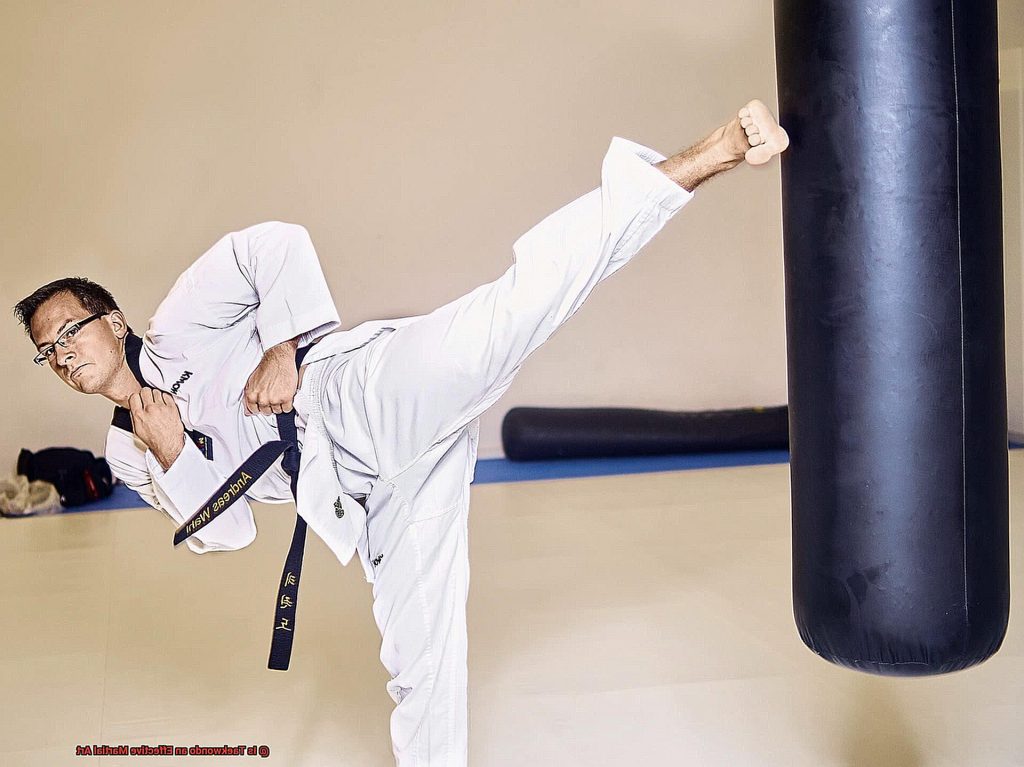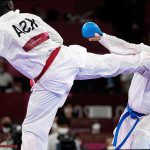Are you searching for the perfect martial art to suit your interests and goals? With so many options available, it can be overwhelming to make a decision. Taekwondo is a widely practiced martial art that has gained popularity for its high kicks and flashy techniques. But the question remains: is Taekwondo truly effective in real-world self-defense situations?
Originating in Korea, Taekwondo has been recognized as an Olympic sport since 2000. While some critics argue that it’s all show with little practicality, others swear by it as an effective form of self-defense and physical fitness. So, what’s the truth?
In this blog post, we’ll explore the world of Taekwondo in-depth. From its history to its techniques, we’ll examine the pros and cons of training in this martial art. We’ll also delve into how effective it can be in real-world scenarios and help you make an informed decision about whether or not Taekwondo is the right choice for you.
So, join us on this journey as we uncover the truth behind Taekwondo’s effectiveness as a martial art.
What is Taekwondo?
It’s a Korean martial art that has been around for over 60 years and is practiced by millions of people worldwide. Taekwondo is a unique and powerful form of self-defense that combines elements of karate, Chinese martial arts, and traditional Korean martial arts.
The word “Taekwondo” can be translated to mean “the way of the foot and fist,” which aptly describes its emphasis on using the legs and feet as weapons. Practitioners of Taekwondo are known for their high kicks and fast footwork, making them very effective in a self-defense situation. Imagine being able to strike an attacker from a distance, without getting too close to them. That’s the power of Taekwondo.
In addition to physical techniques, Taekwondo also emphasizes mental training, teaching practitioners discipline, focus, and confidence. These qualities can help them stay calm and react appropriately in a dangerous situation.
But Taekwondo isn’t just about self-defense; it’s also an excellent way to promote physical fitness. Its emphasis on agility, balance, and coordination makes it a great workout for people of all ages and skill levels, providing both physical and mental benefits.
One of the defining characteristics of Taekwondo is its focus on speed and agility. These are both important qualities in a self-defense situation where being able to move quickly and avoid an attacker’s strikes can be crucial in staying safe. Moreover, Taekwondo provides training on how to defend oneself against multiple attackers, which is especially useful in situations where more than one person is threatening your safety.
Taekwondo has gained immense popularity worldwide and has even been included in the Olympic Games since 2000. It’s not just a martial art; it’s a way of life that promotes physical fitness, mental toughness, and personal growth.
High Kicks and Fast Strikes
When it comes to Taekwondo, high kicks and fast strikes are some of the most visually impressive techniques in the martial art. But the real question is, how effective are these moves in a self-defense situation? The answer is yes, but only with proper training and execution.
Taekwondo’s high kicks are used to target an opponent’s head or torso, while fast strikes aim for vulnerable areas such as the eyes or throat. These techniques can certainly be effective, but they require a great deal of practice and skill to master.
To execute high kicks and fast strikes effectively, a practitioner must have excellent balance, flexibility, and coordination. These skills take time to develop through regular training and practice. However, high kicks can leave a practitioner susceptible to attacks from below while fast strikes demand precision to be effective.
Despite these challenges, many Taekwondo practitioners argue that high kicks and fast strikes can be highly effective in a real-world self-defense situation when combined with other techniques like grappling and ground fighting. A well-rounded defense strategy that utilizes all of one’s skills is key.
At the end of the day, the effectiveness of high kicks and fast strikes in Taekwondo comes down to the skill and training of the practitioner. With dedication and practice, these techniques can be highly effective in a real-world self-defense situation. However, it is important to remember that no martial art is foolproof and that self-defense situations are unpredictable and chaotic. Thus, practitioners should remain well-rounded and prepared for any situation that may arise.
High kicks and fast strikes may be flashy in Taekwondo but are only useful in self-defense situations with proper training and execution. Combining these moves with other techniques can create a well-rounded defense strategy for any unpredictable situation.
Speed and Agility
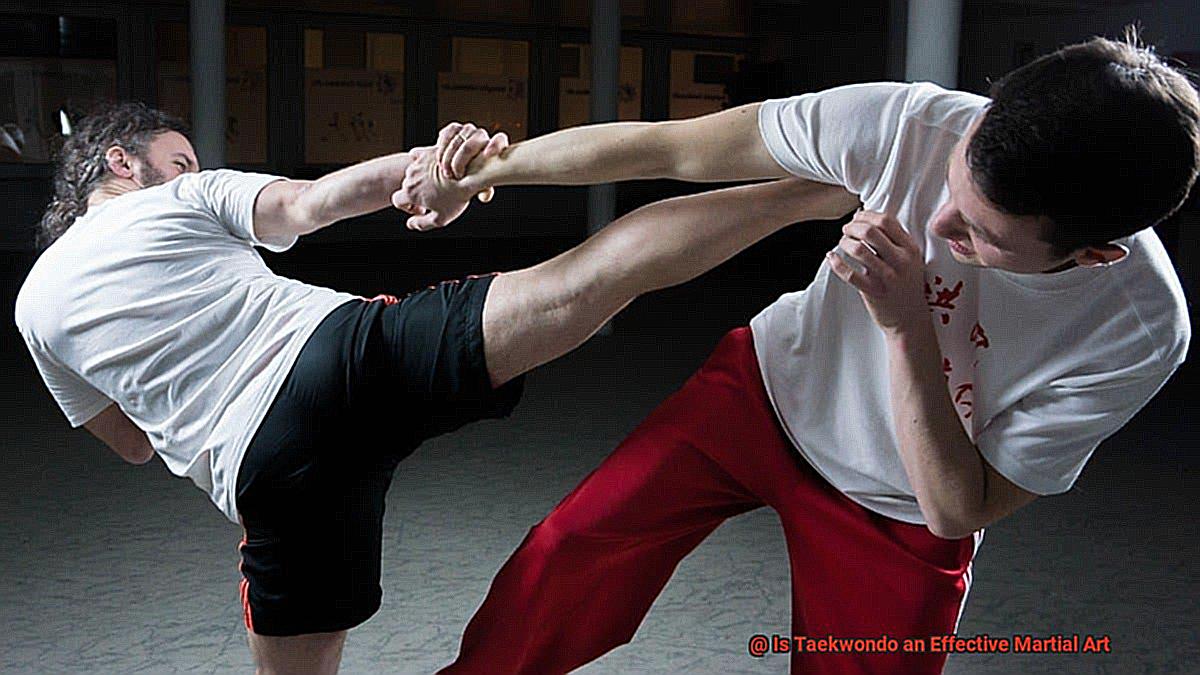
Fast reflexes, efficient movement, and lightning-quick responses are essential for success in this martial art.
To develop these skills, Taekwondo training methods incorporate a variety of exercises like jumping drills, sprinting drills, quick footwork drills, and reaction drills. These drills work together to enhance a student’s reflexes, coordination, balance, and overall body control. The result is a well-oiled machine that can move with speed, precision, and power.
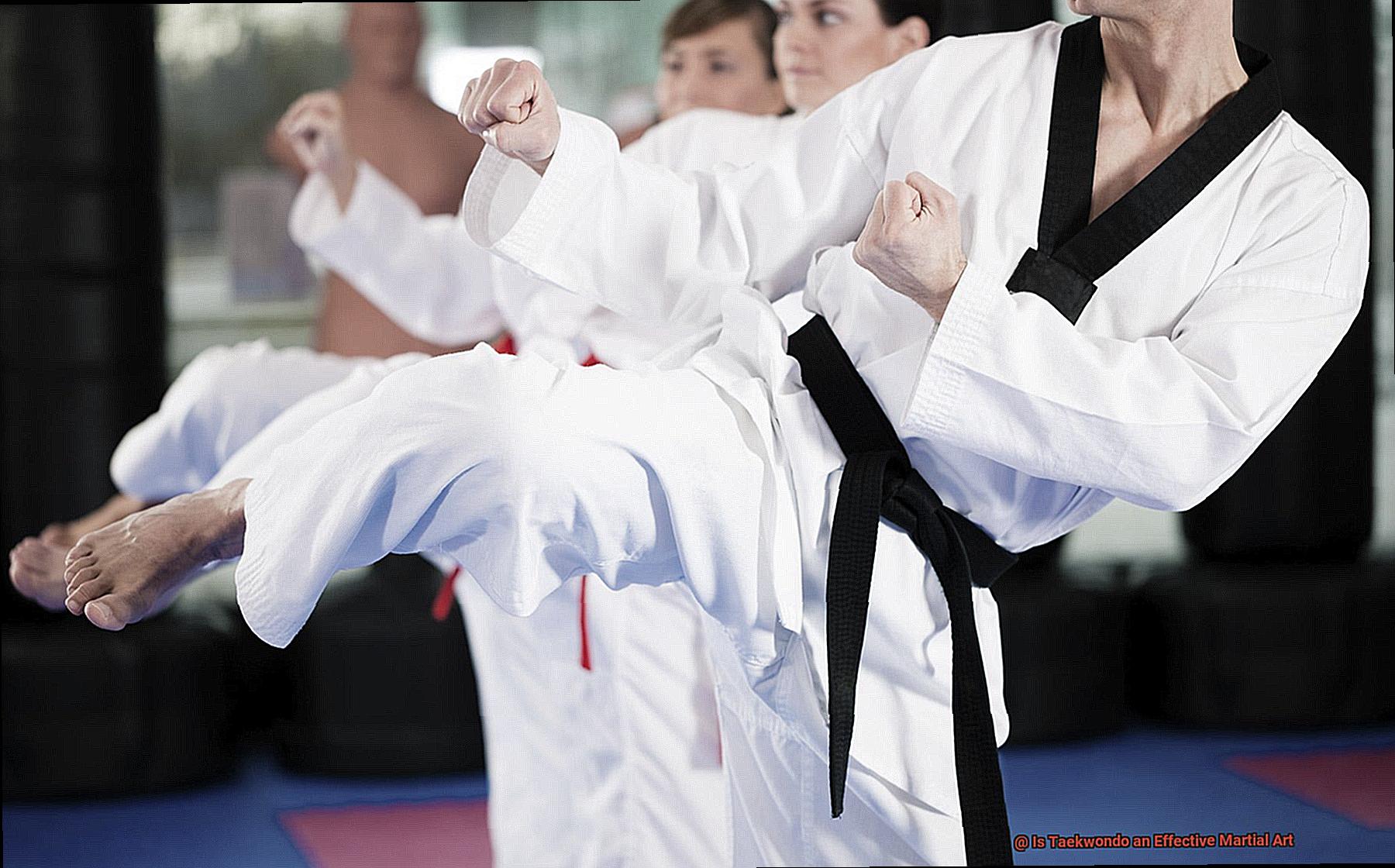
But that’s not all – Taekwondo training also emphasizes the development of fast-twitch muscle fibers that enable practitioners to execute quick and explosive movements. Heavy bags and focus pads are staple tools in training to improve striking speed, accuracy, and develop muscle memory necessary for executing strikes quickly.
Perhaps most impressive of all is the kicking technique in Taekwondo. It requires exceptional flexibility and balance to execute high-speed kicks with precision. The training methods aim to improve flexibility while strengthening leg muscles, so practitioners can perform kicks higher than other martial arts with ease.
In conclusion, Taekwondo places immense importance on developing speed and agility. Its training methods aim to enhance a student’s reflexes, coordination, balance, and overall body control by developing fast-twitch muscles and flexibility.
With precise kicks executed at lightning-fast speeds and explosive movements powered by fast-twitch muscles, Taekwondo practitioners are formidable martial artists.
Dealing with Multiple Attackers
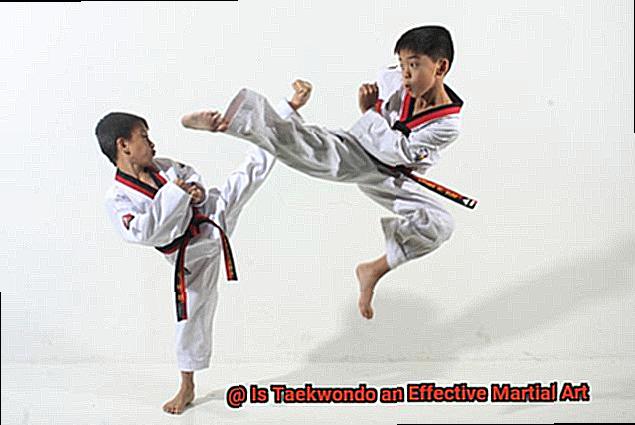
Imagine being in a situation where you have to face multiple attackers. It’s a daunting scenario that requires a specific set of skills and techniques. Luckily, Taekwondo practitioners are trained to face such situations head-on, making them well-equipped to handle multiple attackers.
Keep Moving
One of the essential techniques in Taekwondo for dealing with multiple attackers is to keep moving. Staying mobile allows you to avoid getting trapped or cornered by your opponents.
It also helps create distance between yourself and the attackers, making it harder for them to land a hit. In Taekwondo, footwork is emphasized, ensuring that practitioners can move quickly and efficiently.
Use Peripheral Vision
Another crucial technique is using peripheral vision effectively. When facing multiple attackers, it’s essential to keep an eye on all your opponents to anticipate their moves and react accordingly.
Taekwondo practitioners are trained to develop their peripheral vision, allowing them to see their surroundings without having to turn their heads. This skill enables them to keep track of all the attackers’ movements simultaneously.
Quick Strikes and Kicks
Quick strikes and kicks are also critical when dealing with multiple attackers. Taekwondo emphasizes using fast and powerful strikes, making it harder for opponents to get close enough to land a hit. High kicks can also be effective in keeping attackers at bay while giving you time to plan your next move.
Lastly, joint locks and takedowns are used as means of dealing with multiple attackers in Taekwondo. By taking down one opponent quickly, you can use them as a shield or leverage against the others. Joint locks can also be an effective way of controlling your opponents’ movements while keeping them subdued.
Taekwondo is a comprehensive martial art that equips its practitioners with the necessary skills and techniques for dealing with multiple attackers effectively.
Its emphasis on footwork, peripheral vision, quick strikes and kicks, joint locks, and takedowns make it an ideal choice for those looking to learn self-defense in challenging situations.
Mental Training
When it comes to Taekwondo, mental toughness is just as important as physical strength. The discipline demands a lot from its practitioners, both on the mat and off it. That’s why mental training is such a crucial aspect of Taekwondo. It’s what sets it apart from other martial arts and makes it such a powerful self-defense system.
At the core of mental training in Taekwondo is visualization. By imagining themselves performing techniques and sparring scenarios in their minds, students become more confident and comfortable with their skills. This leads to better performance in competitions and helps them overcome fear and anxiety.
Goal-setting is another critical component of mental training. Taekwondo students are taught to set both short-term and long-term goals for themselves. These goals give them direction and focus, whether it’s perfecting a specific technique or winning a tournament. Achieving these goals boosts their confidence and motivates them to keep improving.
In addition to visualization and goal-setting, meditation and breathing exercises are also emphasized in Taekwondo’s mental training. Meditation helps students clear their minds and stay focused, while breathing exercises help them control their body’s response to stress. Together, these techniques help students develop mental resilience and emotional stability.
Overall, mental training is an essential part of Taekwondo that helps students develop the mental toughness needed for success. It teaches them to control their minds and achieve their goals both on and off the mat.
Pros and Cons of Taekwondo for Self-Defense
Taekwondo is a dynamic and popular martial art that has become a go-to choice for individuals looking to learn self-defense techniques. However, like any combat sport or martial art, Taekwondo has its pros and cons when it comes to using it for self-defense.
On the upside, Taekwondo is renowned for teaching practical self-defense techniques that can be applied in real-life situations. From blocks, strikes, kicks, and throws, individuals can acquire the skills they need to defend themselves effectively.
Moreover, engaging in Taekwondo can significantly contribute to one’s fitness and flexibility. The vigorous physical activity involved in Taekwondo can help build overall strength and endurance, which are essential in a self-defense situation. Additionally, the stretching exercises involved in this martial art can improve flexibility, reducing the risk of injury during an altercation.
Taekwondo also develops mental fortitude by teaching discipline, focus, and perseverance. This mental strength plays a crucial role in building confidence and resilience in the face of danger.
On the flip side, there are certain limitations of using Taekwondo for self-defense. The most prominent one is its limited grappling techniques. Taekwondo concentrates primarily on striking techniques and has limited grappling techniques. In a self-defense situation where the attacker is close-range or on the ground, this lack of grappling techniques can be a disadvantage.
Another drawback of using Taekwondo for self-defense is that it is often practiced as a sport. As such, competition rules may differ from real-life self-defense situations, leading to habits that may not be effective in an actual scenario.
Finally, mastering effective self-defense techniques through Taekwondo training takes time and practice. Therefore, it may not be feasible for individuals who need quick self-defense skills.
Taekwondo can undoubtedly be an effective martial art for self-defense if individuals are willing to invest their time and effort in learning practical techniques and developing their physical and mental strength. However, it is crucial to keep in mind the limitations of Taekwondo and understand that it may not be suitable for all self-defense situations.
z-cyiaQyKcw” >
Conclusion
To summarize, Taekwondo has become a popular martial art globally due to its flashy techniques and focus on high kicks and fast strikes. However, the question remains: is Taekwondo effective for self-defense in real-world situations? The answer is yes, but it requires proper training and execution.
Taekwondo combines physical techniques with mental training, teaching discipline, focus, and confidence. Its emphasis on speed and agility makes it an excellent choice for improving reflexes and reaction time. Additionally, it equips practitioners with skills to handle multiple attackers effectively.
However, like any martial art or combat sport, Taekwondo has its pros and cons when used for self-defense. It may not be suitable for all situations as it lacks grappling techniques. Moreover, mastering effective self-defense techniques through Taekwondo training takes time and practice.
Overall, Taekwondo can be an effective martial art for self-defense if individuals are willing to invest their time and effort in learning practical techniques while developing their physical and mental strength. It’s more than just a martial art; it’s a way of life that promotes personal growth while providing practical self-defense skills.

